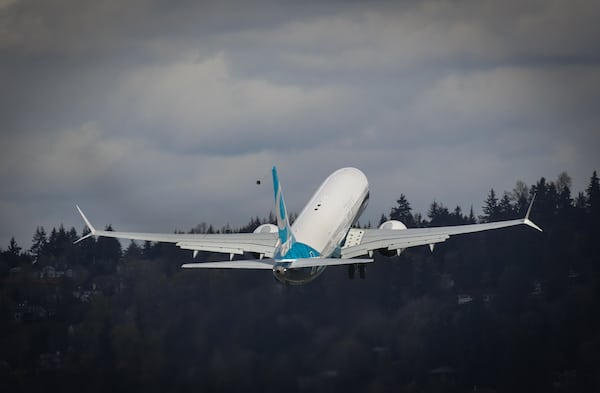
Boeing 737 MAX-9. Photo courtesy of Boeing
While Boeing’s Commercial Airplanes business unit reported one of its most successful quarters Wednesday, most of the questions lodged at chief executive Dennis Muilenburg on the third quarter earnings call focused on the recent Airbus-Bombardier C Series partnership. But with a commercial airplane order backlog standing at 5,700 airplanes worth $412 billion, Muilenburg said the partnership between Airbus and Bombardier has no immediate impact on their commercial airplane product strategy moving forward.
Airbus’ intention to acquire a 50% stake in Bombardier’s C Series program is primarily for a marketing, sales and customer support role. That announcement came a little more than a month after the U.S. Commerce Department’s International Trade Commission made a preliminary recommendation to impose a 219.63% tariff on every C Series delivery, which was the result of a lawsuit petitioned by Boeing against Bombardier under an accusation that the Canadian airplane maker was selling the C Series at below market value and received illegal government financial assistance in manufacturing it.
During the third quarter earnings call, Muilenburg addressed the situation in response to several questions on the matter from both reporters and analysts. Many analysts and reporters speculated that with a partner like Airbus, Bombardier could establish a major footprint within the 100- to 150-seat commercial market segment, most notably evident from a strong order for the C Series placed by one of Boeing’s biggest U.S.-based customers, Delta Air Lines, in 2016.
But a number of factors will make that a very difficult task. First, the partnership between Airbus and Bombardier still needs to clear regulatory review, which Airbus doesn’t expect to occur until the second half of 2018. That’s also when the U.S. Commerce Department will make a final decision on whether to impose a potential 300% import tariff on all C Series imports delivered to U.S.-based customers.
Second, out of the 5,700 orders in its backlog, more than 4,400 of those are for 737s, and Boeing is actually oversold on production slots for 737s through 2020.
While the 737 family does not feature a seating configuration that can compete in the 60- to 150-seat range Bombardier is targeting, the 737 MAX 7 has a seating range of 138 to 152 seats. So even if Bombardier does start to see stronger demand for the C Series under its partnership with Airbus, Boeing still has more than 4,400 orders to fulfill for its most popular model airplane. Therefore, the world’s largest airplane maker wouldn’t feel any real competitive threat there for at least the next three years.
“Recent changes in the marketplace and the discussions between Airbus and Bombardier don’t change our plans,” said Muilenburg. “We have a strong strategy in place, we’ll continue to look at our strategic alternatives, but we don’t need to change the path that we’re on.”
Muilenburg also announced the company’s plans to increase production from its current production rate of 47 per month to 52 per month in 2018 and 57 per month in 2019. That would mean on a 22-day per-month production cycle, even by building nearly three 737s per day, Boeing still can barely keep up with the production demand for its airplanes that theoretically compete with the C Series.
Where the C Series does present a threat and some differentiation is in its performance, which, according to airlines that currently operate the aircraft that recently spoke to Avionics, is phenomenal. The CS300 features a three-axis fly-by-wire system with Cat IIIb autoland. Bombardier claims it has an operational cost that is up to 18% lower than “larger re-engined aircraft.”
In September, Bombardier released a 20-year market forecast for the 60- to 150-seat segment, which the OEM believes has demand for 12,550 aircraft worth $820 billion. The 100- to 150-seat segment will represent 70% of the revenues, 6,800 aircraft valued at $580 billion, followed by the 60- to 100-seat segment with 5,750 deliveries worth $240 billion, Bombardier said.
Embraer’s next-generation E2 regional jets will also present a strong competitor to Airbus, Boeing and Bombardier in this segment.
Another potential advantage of the Airbus-Bombardier C Series partnership is the plan for Airbus to add a C Series production line to its U.S.-based facility in Alabama, which would theoretically allow it to avoid the previously mentioned import tariff. Boeing, however, believes even if the Airbus-Bombardier partnership clears regulatory approval and the aircraft is built in the U.S., the C Series would still face the tariff.
“Bombardier’s actions on the C Series where they have received illegal subsidies and engaged in illegal dumping behavior, this will be evaluated by the Commerce Department and we’ll wait that out,” said Muilenburg.
“We don’t see the recent announcements around the partnership plan, or a new production line changing that process, or changing our position on the fact that the trade matter needs to be addressed. It’s important that everybody plays by the same rules,” he added.